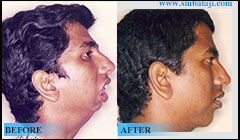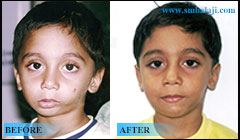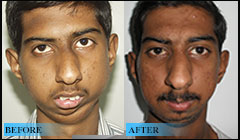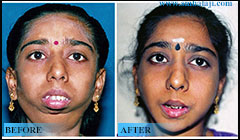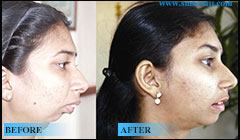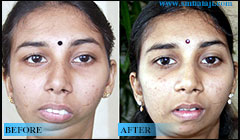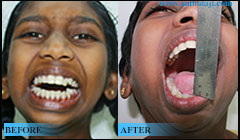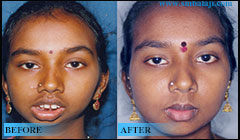TMJ Growth Defects
Some persons, by birth, may be affected by disorders of the TMJ. In some instances, the growth of the condyle i.e. the component of the lower jaw forming a part of the TMJ may be affected.
MicrognathiaA child’s lower jaw may sometimes be comparatively undersized than the upper jaw. This condition is termed as Micrognathia. The growth of muscles would also be simultaneously affected as the bony structure is smaller than normal. This condition could also be associated with various syndromes (Pierre-Robin’s Syndrome, Treacher Collin’s Syndrome etc). As the lower jaw is small, the tongue gets pushed backwards and tends to block the air passage. Distraction Osteogenesis is an effective treatment option to lengthen the jaw size. By this procedure the jaw can be brought to the normal size, without the necessity of bone grafting (bone harvested from hip bone to lengthen the jaw size).
Hemifacial MicrosomiaIn some individuals, there may be an imbalance between right and left sides of the face. This type of facial growth deformity characterized by facial asymmetry is called Hemifacial Microsomia.
In this condition, the structures of one side of the face grow lesser than the other side. This results in asymmetry of the face. The affected side of the face appears disproportionately smaller than the other.
Surgical correctionChoice of treatment to correct growth defects of the TMJ depends on many factors including age of the patient, severity of the defect and other associated deformities present, if any.
Distraction Osteogenesis is the latest advanced and effective treatment option to lengthen the jaw length and correct facial asymmetry. By this procedure the jaw can be brought to the normal size, without the necessity of bone grafting (bone harvested from hip bone to lengthen the jaw size).
On the deficient side of the face, the jaw bone is cut and the distractor device is fixed. The two arms of the device are fixed to the two cut segments of bone. After a few days, a screw attached to the device is turned which pushes the two bone segments apart. New bone is formed in the resultant gap and the jaw bone gradually lengthens. After the desired volume of bone is formed, the distractor device is removed.
Dr. S.M. Balaji’s expertise in distraction osteogenesis for correction of TMJ defects is exceptional and has met with great success.
Another treatment is by using a bone graft from the patient’s own rib (Costochondral graft). This may be commonly done to restore severely affected mandibular condyles in growing children. The bone graft is fixed to the existing deficient portion of the mandible (lower jaw bone) using wires or screws.

